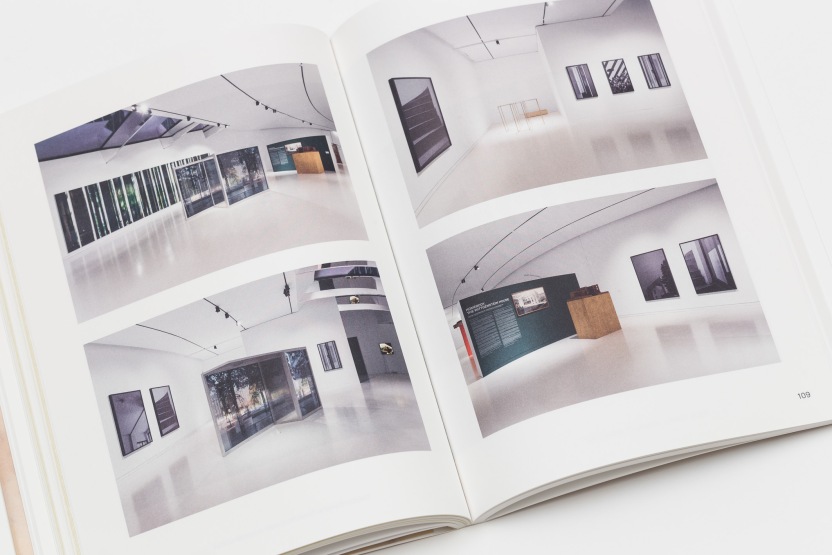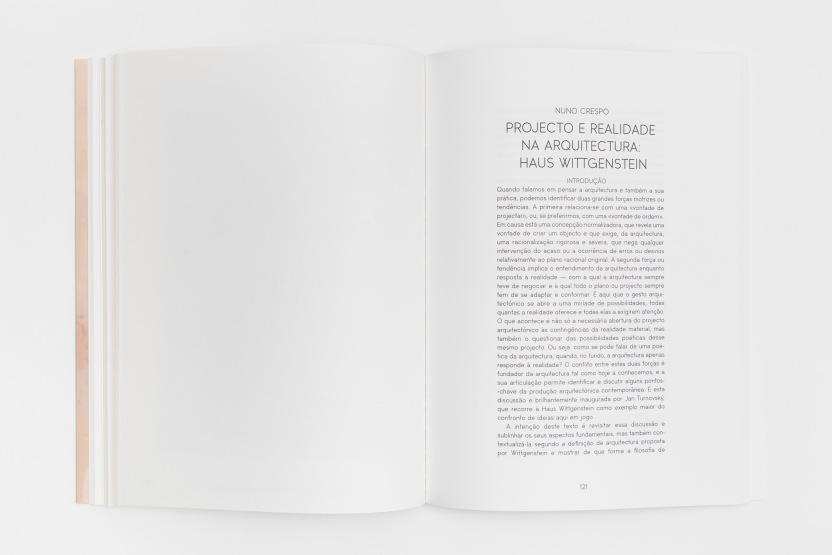
This book is the catalogue of the exhibition entitled Haus Wittgenstein, presented at the Museum of Art, Architecture and Technology (Main Gallery, 06.11.2018 – 25.02.2019). This condition, clearly and unreservedly assumed, gives the book a character of its own, which is not limited to the documentation of an event, but that takes advantage from this function.
Instead of making a book that, although published on the occasion of the exhibition, tries to narrow this link (perhaps hoping to achieve a more lasting relevance), it became clear that the book would only benefit from being a testimony to the proposals by Nuno Crespo, curator of the exhibition, and the artists he summoned around the theme — the Haus Wittgenstein in Vienna —, and in particular those who specifically conceived and developed new works.
The peak of this relation, between the book and the artworks, it’s probably reached with the publication of the interviews that Ana de Almeida carried out during the research for the commission, and which the artist ended up incorporating in her work (A Casa, 2018) as a sound element. The testimonies of Bernhard Leitner, Pierre Stonborough and Radmila Schweizer proved to be essential to the book, assuring the presence of a kind of information that otherwise could not be achieved. On the other hand, the book made it possible to register a part of Ana de Almeida’s proposal that would otherwise only be available during the exhibition period, increasing its accessibility.
At another moment in the book, right in the beginning, the Haus Wittgenstein is introduced to the readers by means of a set of photographs taken by Nuno Cera during his stay in Vienna, at an early stage of the project. As one realises after going through the book, these images do not appear in the two pieces that the artist proposed for the exhibition (Untitled, 2018, and HW, 2018). Their nature is evidently distinct and constitute a document that contributes so much to the recognition of the subject of the book, as it allows to deepen certain aspects of the house that are focused by the artists and also the authors of the texts.
The book also deepens its relationship with the exhibition in another aspect, the reproduction of the works. In a practically continuous section (only interrupted with the “texts of the works”, some of them already mentioned) is presented a sequence of views of the exhibition realised by the photographer Bruno Lopes. A traveling shot through the space of the exhibition, in which the camera stops on the works, either in groups or individually. Apart from these records (and the aforementioned portfolio) there are no other images in the book.
All these features are effectively structured and surprisingly materialised by the design that the studio ATLAS Projectos conceived and developed for the book. While soberly reacting to the limitations and specificities of the contents and the constraints of the project, they committed themselves to pursue an objective and contemporary relation with the subject, avoiding fetishization. The result is an object that is anchored in an approach that is perhaps more common in art, but which is still recognisable in the work of designers who have chosen more conceptual practices. One of the signs of this approach can be illustrated by “A note on type” that the designers decided to include in the credits:
“This volume is exclusively composed in Bespoke (60 versions, more exactly), a typeface designed by Alexis Reigel and Marco Müller in 2012, to be used in www.metaflop.com — an open-source web application that allows users to modulate certain parameters, and download free custom versions. Metaflop uses METAFONT, a font description language developed by Donald Knuth in 1979. Unlike common typefaces, where the outline of the character is fixed, here each character is defined only by a set of geometrical equations. Thus, what we have is not a set of set letters, but a set of set parameters, that allow modulation. Each time it is rendered, it results in, not so much a font, but rather a metafont.”






“Haus Wittgenstein, the exhibit which this book is based on, has precisely at its core the problem the inherent singularity of the building itself poses, being a house designed by a famous philosopher, a man of an eccentric, passionate nature, in a Vienna then in the throes of a ‘gay apocalypse,’ to quote the exhibit held at Centre Pompidou, Vienne 1880–1938 L’apocalypse joyeuse (1986), curated by Jean Claire, but also celebrating ‘the man without qualities’ (as Robert Musil would name him in his important literary work first published in 1930).
Given the historical, cultural, architectural singularity at stake, we simply cannot fit this project into any specific place in the history of architecture, philosophy, or art, and its authorship still raises issue, since in its initial stages, the project involved architect Paul Engelmann, who then handed it over to the philosopher, who then gave it detail and had it built, imbuing it with an unique nature and character. Some are of a mind that the house merely replicates the main architectural ideas of Adolf Loos, while others view it as a singularity in the history of architecture. The house served as a dwelling for the Nazis and then the Russian troops turned it into a stable, then it was abandoned and nearly ended up demolished, until Bernhard Leitner headed a relentless campaign to save the building and Haus Wittgenstein was promoted to national landmark in the 1970s. Then it was sold to the Bulgarian government to house a cultural institute that defied description, and then came decline yet again.
This book celebrates the 90th anniversary of Haus Wittgenstein, fetishised as few works in both the history of philosophy and that of Vienna. The project began in 1926 and came to its conclusion in 1928, and from it stemmed a passionate story where art, architecture and philosophy intersect — not only because it came from the mind of Wittgenstein the philosopher, but also because conceiving it, building it and inhabiting it involved all manner of conflict, anecdotes, and personal relationships that would go on to inspire so many artists, architects, and writers.
Imbued as it is in philosophy — it marked Wittgenstein’s troubled return to philosophy and the forgoing of logic in favour of confronting the world head-on, with all its ordinary details and all that pertains men, or how ‘everyday’ and ‘ordinary’ were promoted to aesthetical categories, a development which would ripple through so much of contemporary art and photograph — the house lends itself to passionate debate; the themes developed in the project, all the detailing, the obsession with symmetry and exactness, all of it led to an abundance of anecdotes and stories, and Haus Wittgenstein is all the more worthy of studying and analysing because of it.
This book, and the exhibit which inspired it, give us an opportunity to revisit Haus Wittgenstein through a series of new pieces commissioned to celebrate its 90th birthday, all of which engage in critical dialogue with the house as a piece of architecture. Joining those pieces, we then have pieces from artists that in one way or another experienced the ‘Wittgenstein effect’ and the philosopher’s enthrallment with language, sense, and the world.”
— Nuno Crespo, “Rose is a rose is a rose is a rose.” in Haus Wittgenstein, MAAT / Fundação EDP, Lisboa, 2018, pp. 25-27.
The book is on sale at the MAAT store (EUR 35) and is distributed by Monade.
HAUS WITTGENSTEIN
MAAT / Fundação EDP, Lisboa, 2018
Texts in Portuguese and English by Nuno Crespo, António Guerreiro, et al.
Design by ATLAS Projectos
Photography by Bruno Lopes
210 × 280 mm; soft cover with flaps; Swiss binding; 186 pp.
ISBN: 978-972-8909-72-7
600 copies
Photos of the book by Bruno Lopes